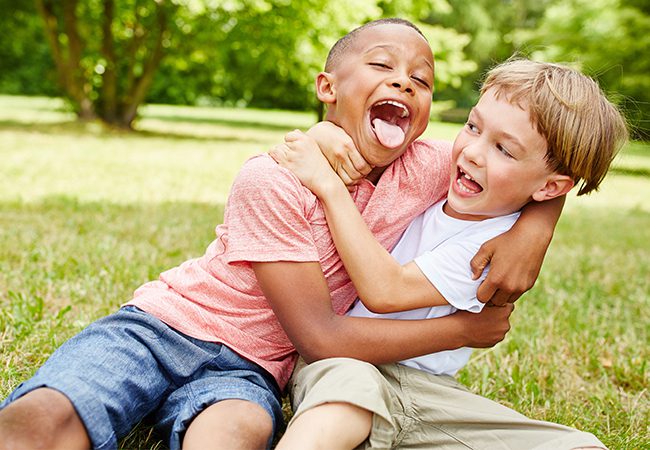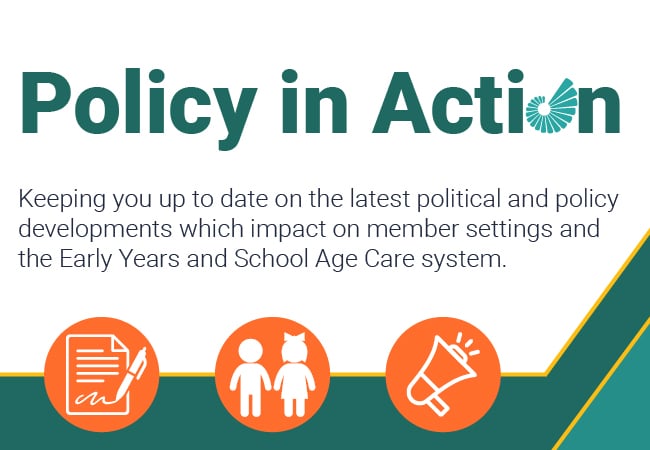Rough and tumble play – what do you think?

Over the last few weeks of Scéalta blog posts, we have delved into play and in particular to play in the outdoors. We are all aware of the benefits of outdoor play and increasingly mindful of the power of play itself. When I thought about the play and wrote about how the play was discussed at a symposium which I attended previously, I thought back to when I completed my master’s thesis, the title of which was ‘Keeping an EYE on Play’ Early Years Educators understanding of play, and the theories, experiences and assumptions that underpin it.
What struck me during my research was how difficult it was to come up with a clear definition of play, to get all the theorists at the time to agree on a single definition. Since completing my research I know a lot more about play, particularly how complex it is and how necessary it is in children’s social and cultural lives. In my research, one of the areas that stood out for me during my data collection was around early years educators’ perceptions of rough and tumble play (R & T).
While many educators recognised it as a play category, seeing it as necessary for healthy child development, many others perceived it as aggressive play, often intervening if it looked like it was getting too rough. Rough and tumble play refers to vigorous behaviours, such as wrestling, grappling, kicking, tumbling and play fighting. These behaviours may appear aggressive except that they are part of a playful framework. Costabile et al. (1991) developed a taxonomy of R & T behaviours, observed through non-verbal signals, including what they termed the play face, these were not present in aggressive forms of behaviour.
This type of play face can in fact be seen in animals too. If you ever witness a puppy waiting on his/her master to throw a stick, the puppy shows an open mouth, exciting behaviours, panting, ears pointed, eyes fixed, and body poised for action. If you observe children about to tumble and roll around with another child, you will see similar traits, body stiffened ready for action, eyes fixed and a smile or playful expression on their faces. These are also known as play cues, and studies have shown that children are much better at distinguishing between rough and tumble and aggressive play behaviours than most adults, using these play cues to differentiate! So, for educators in early years settings, it is helpful to stand back, observe what the children are exhibiting in their play, and be ready to intervene when the play cues are gone.
Throughout my research, I did note that educators would often cite children’s desire for physically risky play experiences. And these were often allowed to happen in the outdoors, where the physical space provided opportunities for challenge, testing limits, and exploring boundaries.
However, I did also find that many educators were uncomfortable with children engaging in rough and tumble play, having fears that things would get ‘out of hand’ and a child might get hurt. When I explored this further it emerged that gender and attitudes toward this type of play very much dictated whether children were encouraged to engage in it or not and opportunities for positive risk-taking in early childhood environments depended on early years’ educator’s views on risk.
There were also issues of parents’ expectations and having to explain how a child might have got hurt while engaging in more boisterous play. Valid concerns, but perhaps to the detriment of children engaging in rough and tumble play and the multiple developmental domains which are stimulated through this type of play.
Research suggests that the elimination of aggressive sociodramatic play, such as play fighting, and rough and tumble play may impact on the optimal education and development of young children, particularly boys, (DiPietro, 1981; Jarvis, 2007; Logue & Harvey, 2010; Pellegrini, 2010). Sutton-Smith (1975) suggests that any educational programme that restricts play types will foster play deficits, which inadvertently will leave children unprepared for future experiences. (Playful Aggression in Early Childhood Settings, J. L. Hart and M.T. Tannock (2013).
Have you thought about any instances of rough and tumble play happening in your setting? I would encourage you to take a little time, look, wait and observe children engaged in play, watching in particular for a look, a gesture, a verbal invitation, a provocation, testing out, facial or bodily display, a presentation of an object or an action. Some of these actions may be the play cues children are exhibiting, which distinguishes between rough and tumble (R & T) play and aggression.









